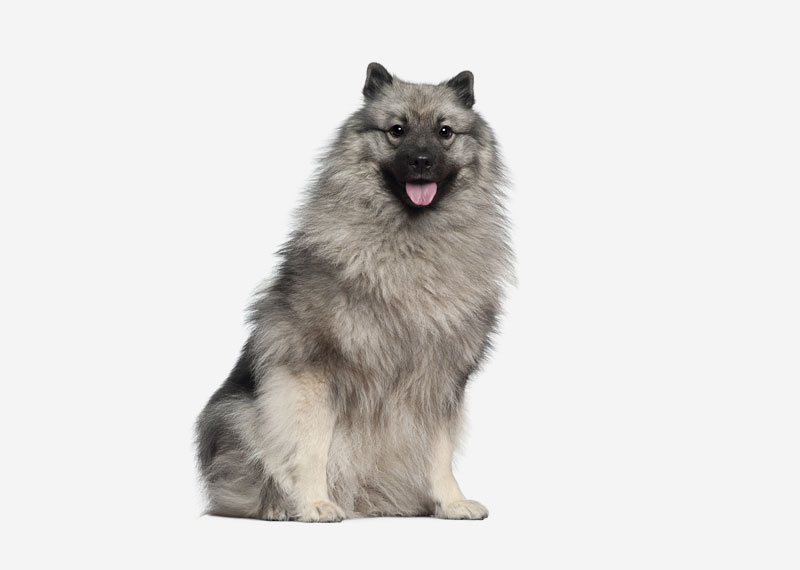The Keeshond plural: Keeshonden) is a medium-sized dog with a plush two-layer coat of silver and black fur with a ruff and a curled tail. It originated in Germany, and its closest relatives are the German spitzes such as the Großspitz, Mittelspitz, and Kleinspitz or Pomeranian. Originally called the German Spitz, more specifically the Wolfspitz, the name was officially changed to Keeshond, in 1926 in England, where it had been known as the Dutch Barge Dog.
History
The Keeshond was named after the 18th-century Dutch Patriots (faction), Cornelis de Gijselaar (spelled 'Gijzelaar' in Modern Dutch), leader of the rebellion against the House of Orange. The dog became the rebels' symbol; and, when the House of Orange returned to power, this breed almost disappeared. The word 'keeshond' is a compound word: 'Kees' is a nickname for Cornelius (de Gyselaer), and 'hond' is the Dutch word for dog. In the Netherlands, "keeshond" is the term for German Spitzes that encompass them all from the Pomeranian to the Wolfspitz (Keeshond). The sole difference among the German Spitzes is their coloring and size guidelines. Although many American references point to the Keeshond as we know it originating in the Netherlands, the breed is cited as being part of the German Spitz family originating in Germany along with the Pomeranian (toy or dwarf German Spitz) and American Eskimo dog (small or standard German Spitz) according to the Fédération Cynologique Internationale.The first standard for "Wolfspitz" was posted at the Dog Show of 1880 in Berlin. The Club for German Spitzes was founded in 1899. The German standard was revised in 1901 to specify the characteristic color that we know today, "silver grey tipped with black". In the late 19th century the "Overweight Pomeranian", a white German Spitz and most likely a Standard German Spitz, was shown in the The Kennel Club. The "Overweight Pomeranian" was no longer recognized by the British Kennel Club in 1915. In the 1920s, Baroness van Hardenbroeck took an interest in the breed and began to build it up again. The Nederlandse Keeshond Club was formed in 1924. The Dutch Barge Dog Club of England was formed in 1925 by Mrs. Wingfield-Digby and accepted into the British Kennel Club in 1926, when the breed and the club were renamed to Keeshond.Carl Hinderer is credited with bringing his Schloss Adelsburg Kennel, which he founded in 1922 in Germany, with him to America in 1923. His German Champion Wolfspitz followed him two by two in 1926. At that time, less than ten years after World War I, Germany was not regarded fondly in England and America; and the Wolfspitz/Keeshond was not recognized by the AKC. Consequently, Carl had to register each puppy with his club in Germany. Despite this, Carl joined the Maryland KC and attended local shows.Carl regularly wrote to the AKC, including the New York headquarters, to promote the Wolfspitz. While going through New York on his way to Germany in 1930, Carl visited the AKC offices and presented Wachter, his Germany champion, to AKC President, Dr. DeMond, who promptly agreed to start the recognition process, with some caveats including changing the name to Keeshond, and asked Carl to bring back all the relevant data from Germany. Carl also translated the German standard to English for the AKC. The Keeshond was accepted for American Kennel Club registration in 1930.Despite intense lobbying the Fédération Cynologique Internationale would not accept the Keeshond as a separate breed since it viewed the Wolfspitz and Keeshond as identical. In 1997, the German Spitz Club updated its standard so that the typically smaller Keeshond preferred in America and other English-speaking countries could be included. This greatly expanded the gene pool and unified the standard internationally for the first time. Now bred for many generations as a companion dog, the Keeshond easily becomes a loving family member.As a result of the breed's history and friendly disposition, Keeshonden are sometimes referred to as "The Smiling Dutchman".
Health
Keeshonden are generally a very healthy breed. Though congenital health issues are not common, the conditions which have been known to sometimes occur in Keeshonden are Hip dysplasia (canine), luxating patellas (trick knee), Epilepsy in animals, Cushing's syndrome, diabetes, primary hyperparathyroidism, and hypothyroidism. Von Willebrand's disease has been known in Keeshonden but is very rare. An accurate (or PHPT) has recently been developed at Cornell University. As with any breed, it is important when buying a puppy to make sure that the parents have been tested and certified free from inherited problems.Keeshonds in a UK Kennel Club survey had a median lifespan of 12 years 2 months. 1 in 4 died of old age, at an average of 14–15 years.When purchasing a Keeshond, make sure to check the health testing available on both parents, both through the breeder, and the public Orthopaedic Foundation of Animals (OFA) health site. www.offa.org






